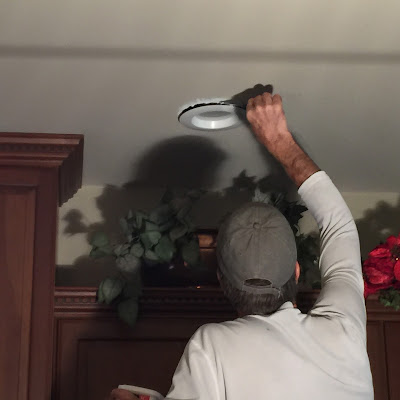 |
| White Ceiling and Trim By Default |
Keeping It Simple: Basic Things to Consider When Choosing a White
Hue Family of the Wall Color
Tint, Tone or Shade?

After you identify the hue parent, decide if the color is a tint (hue plus white), a tone (hue plus gray), or a shade (hue plus black).
Think of tints as pastels and tones and shades as neutralized colors. If your wall color is a tint, avoid the neutralized whites. If your wall color is a tone or a shade, avoid the tint whites. Fortunately, clear, bright tint colors are easy to spot when you're standing in front of the displays at the paint store, helping you to stay in the right area when you're looking for a white that will work.
For example, if you use a neutralized member of the yellow family (a tone or shade) on the walls, look for a neutralized white from the yellow family for the trim. If you have a tint yellow on the walls, use a white tinted with yellow for the trim. If your wall color is a neutral such as a taupe that looks like a green/brown combination, your off-white trim should have at least one of these components.
This isn't the only approach to choosing a white, just a way to keep it simple.
How Much Contrast?
Deciding how much contrast you want between the ceiling, walls and trim should be based in part on how much attention you want to focus on them. With higher contrast colors you need to be sure that that the trim has merit and is attractive and well-proportioned.
 |
| A Collection of Boxes |
LRV (Light Reflectance Value)
If you've decided to have white trim, you can choose a white with exactly the right amount of contrast by looking up the Light Reflectance Value (LRV) for your wall color and then for the whites you're considering.
Paint manufacturers determine the LRV for each color they make by measuring it with a device and numbering the result on a scale of 0 to 100, with 0 being the blackest black and 100 being the most reflective white. An LRV of 50 is the happy medium and the standard for residential interior wall colors. To see contrast between two colors you usually need a difference of at least 7 points. In addition to finding LRV numbers on line at each manufacturer's web site, you can find the values for Sherwin Williams colors on the back of the paint strip and the values for Benjamin Moore colors at the back of the fan deck in numerical and alphabetical order. Comparing LRV values eliminates the need to guess about contrast and is easy to do.
To Sum It Up:
Use plain white for your ceilings and trim only if you love it and after you've done the homework to be sure it works with your wall color. While you're at it, consider branching out by using a color other than plain white. There's a universe of beautiful colors to choose from, and one or more of them is probably a much better choice.













